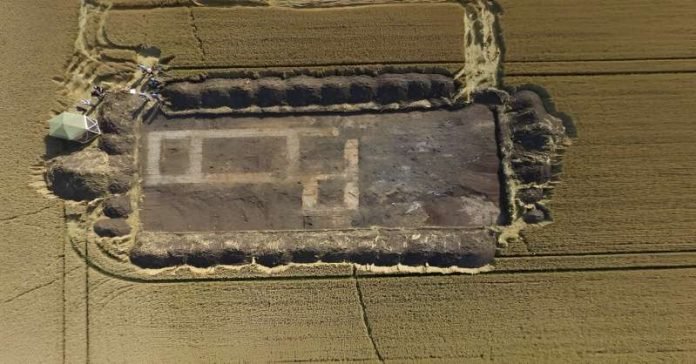
In the heart of Lincolnshire, within the shadow of the medieval ruins of Crowland Abbey, archaeologists from Newcastle University have peeled back layers of time to reveal a sacred landscape that has evolved over centuries.
Their discoveries, detailed in the Journal of Field Archaeology, provide a tangible link to the region’s spiritual past, tracing back to the hermitage of Saint Guthlac in the 8th century and even further to prehistoric ceremonial practices.
Saint Guthlac, a figure of solitude and devotion, is at the center of Crowland’s spiritual heritage.
Renouncing his noble birthright for a life of seclusion, Guthlac’s death in 714 marked the beginning of a veneration that would see the establishment of Crowland Abbey in his honor.
The Vita Sancti Guthlaci, a contemporary account of his life, hints at Guthlac choosing a barrow as his hermitage, a detail that has long intrigued archaeologists.
The site believed to be Guthlac’s hermitage, Anchor Church Field, held secrets buried beneath. Previous to the excavation, the challenges of modern agriculture and the absence of thorough archaeological investigation left the area’s history somewhat speculative.
However, the recent excavation led by experts from both Newcastle University and the University of Sheffield has uncovered a history far more complex and ancient than previously imagined.
Among the earliest finds is a Late Neolithic or early Bronze Age henge, a monumental circular earthwork that stands as one of the largest of its kind in eastern England.
Its presence suggests that Crowland was a ceremonial focal point, a sacred ground distinguished by its natural geography as a peninsula surrounded by water and marshes. This prehistoric structure, visible for centuries, likely attracted Guthlac and other hermits to the site, drawn by its ancient significance.
The archaeological team’s work has unearthed more than just structural remains; it has brought to light artifacts that narrate a story of high status and sacred veneration.
Among these finds are bone combs and fragments of a glass drinking vessel, dating back to the Anglo-Saxon period. While definitive connections to Guthlac himself are elusive, these artifacts, alongside the reoccupation of the henge during his era, underscore the sacred allure of Crowland across millennia.
The narrative of Crowland’s sacred landscape doesn’t end with Guthlac but extends into the medieval period with the construction of a 12th-century hall and chapel by the abbots of Crowland Abbey.
Intended to honor the hermits, these structures served as pilgrimage destinations, evidencing the enduring sanctity of the site.
Though later ravaged by time and human intervention, the essence of the sacred space persisted, manifest in an 18th-century cottage owner who continued to offer prayers in the garden, a site once home to the chapel and hall.
The discovery of a stone-lined pit, initially thought to be a well but now interpreted as a base for a large cross or flag post, further emphasizes the site’s long-standing religious significance.
The transformation of Crowland’s landscape, from a water-bound peninsula to arable land, marks a transition in the site’s usage but not in its sacred identity.
This extensive excavation not only challenges our understanding of Crowland’s spiritual history but also enriches it, offering a glimpse into the deep-rooted veneration that has defined the site for centuries.
The tale of Crowland, from its prehistoric ceremonial origins to its medieval pilgrimage and beyond, underscores the complex layers of faith, history, and human endeavor that intertwine to create a sacred landscape.
The research findings can be found in the Journal of Field Archaeology.
Copyright © 2024 Knowridge Science Report. All rights reserved.



